[Source: Darren Kitson]
The Breakdown Crane
Any railway worth its salt once had a breakdown crane and that included the Marchwood Military Railway. As always with military railways the problem is keeping track of what equipment is at a given location at a given time. It is known that the Ministry of Supply ordered a pair from Cowans Sheldon which were delivered in 1942; they were 30-ton steam cranes w/n 7869/70 of 1942 and one or other of these was at Marchwood at various times.
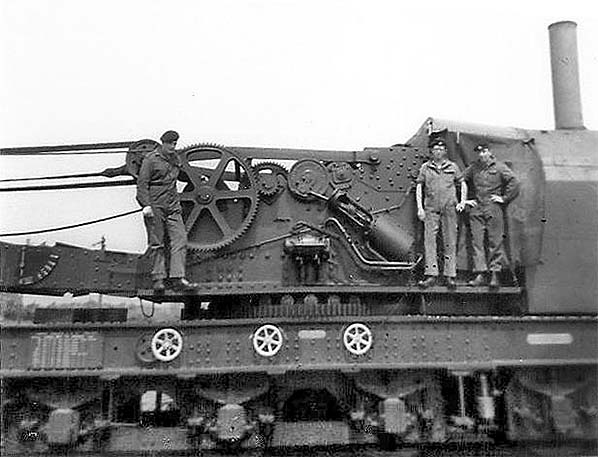
One of the two Cowans Sheldon 30 ton cranes supplied in 1942 seen here in a posed photograph believed taken in 1947. The location is not known. Note the rather odd casing around the boiler which appears to have been recently applied and is suggestive or armour plating.
Photo from the Ted Burgess Collection
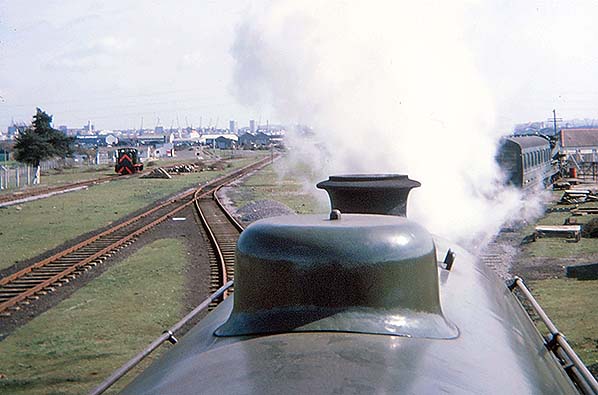
At the time of writing only two reasonably clear photographs of the breakdown crane obviously taken at Marchwood have come to light whereas a couple of others, such as this one, show it in the background. The photograph is taken from Army No.92 as she comes off shed in April 1976, the shed being obscured by steam. On the left, one of Marchwood's Ruston & Hornsby diesel shunters can be seen while in the far distance the cranes of Southampton docks are visible. In the left background is Marchwood's original power station. The breakdown crane can be seen on the right and is at its usual residence, the short spur to the south side of the locomotive shed. The carriage stabled with the crane does not form part of a breakdown train. It is Army No.3301, formerly BR Mk1 suburban No. M46069. This vehicle is better described elsewhere but worth a mention here as this view shows, just, one of the windows cut into its end as part of its adaption to an officers' observation coach.
Photo by Andy Crespin
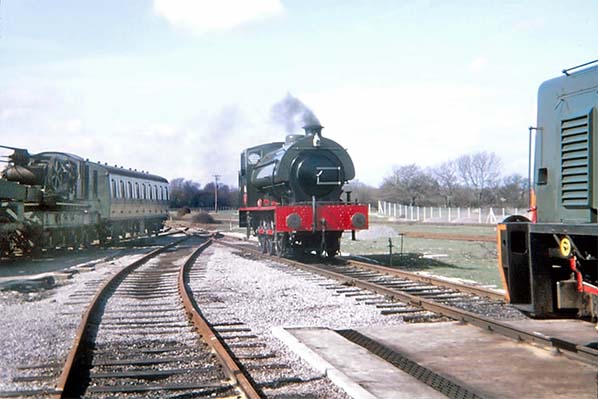
The scene outside Marchwood locomotive shed, behind the camera, one day in April 1976. Present beside a water hydrant is Army No.92 WAGGONER while on the right one of the Ruston & Hornsby LSSH shunters tries only partially successfully to get in the photograph. On the left is Marchwood's Cowans Sheldon breakdown crane. The crane and coach stands on the road which originally served the WWII locomotive shed, which was essentially nothing more than an adapted Nissen hut. By this time the crane had been converted from steam to diesel-hydraulic, in which form former Marchwood Military Railway driver Andy Crespin described it as "bloody awful". Keeping the crane company, but nothing to do with it, is ex-BR Mk1 surburban coach Army No.3301. Originally BR No. M46069 it came to Marchwood via Longmoor in 1969 and was one of three of this suburban type of Marchwood, all of which originated on BR London Midland Region and not, as often stated, on the Eastern Region's King's Cross suburban services. Army No.3301 had been converted into an officers' inspection / observation coach and as it appears to have retained its compartments it was not a 'saloon' as most such conversions were. Where the conversion work was undertaken is something of a mystery; possibly at Longmoor but it may have been done by BR Wolverton Works at the time of sale to the military. It is known that three compartments were removed, with the remainder left intact, but it seems from photographs that all compartment doors were retained. Certainly this view shows all door hinges in place. In addition, windows were cut into the affected end of the vehicle and this would have been an easy enough task as these coaches were, of course, non gangwayed (a feature which gave rise to BR staff referring to them as 'Block Enders'). It is not known what else the conversion entailed but such conversions usually involved the provision of rather posh seats and often in the form of loose chairs and a table. A means of communication with the driver was sometimes provided as were refreshment facilities although it is unlikely these two features were deemed necessary at Marchwood but it should be remembered to coach came to Marchwood from the much larger system at Longmoor. Eventually sold to the Mid Hants Railway, apparently for use as an office at Ropley, it arrived there on 12 December 1978 but was scrapped in 1983 due to its by then poor condition.
Photo by Andy Crespin
At some point in time at least one of the two 30 ton Cowans Sheldon cranes was converted to diesel-hydraulic power. One was scrapped during the 1980s whilst the other found its way to Austria and ended up with OBB (Osterreichische Bundesbahnen - Austrian Federal Railways). It was last heard of in semi-derelict condition at a museum in Vienna and is believed still to exist in 2016.
Diesel Locomotives
With seemingly endless photographs of Austerity saddle-tanks, one might be forgiven for thinking that diesel traction is a relatively recent innovation on the Marchwood Military Railway, but this is not the case. The first confirmed appearance of diesel traction at Marchwood dates from 8 February 1960 when an Andrew Barclay 0-4-0 diesel-mechanical shunter arrived. This was AB w/n 362 of 1942, numbered WD No.827. One of several such locomotives acquired by the military, she later became WD 70047, named ‘MULBERRY’ in June 1962 and remained at Marchwood until 29 June 1965. Her nameplates were, of course, to the usual smart military style fixed near the edge of the running plates. Fitted with a Gardner engine (model unknown) and originally numbered WD 47, she is known to have been in France 1944-46 and at Suez (Middle East) in February 1952 to sometime in 1955 but otherwise spent her life at various military railways at home, most notably Bicester, Long Marston and, of course, Marchwood. She suffered a failure in 1991 and was returned to service at the Foxfield Railway in 1993. She is still active today and remains at Long Marston at the time of writing.
Andrew Barclay Sons & Co Ltd, Kilmarnock, used a separate works number series for their diesel locomotives as w/n 362 may indicate. They had built a number of diesels of various gauges for export but were not a major player in the British standard gauge diesel market until after WWII. Nevertheless their diesel locomotives earned a reputation for ruggedness and reliability. They were also relatively easy to operate and drivers mastered them quickly, unlike certain other diesel-mechanical shunters which were challenging. For British Railways, Barclay supplied a number of 153bhp 0-4-0 types as well as 0-4-0 and 0-6-0 204bhp types, the best known of which became BR Class 06
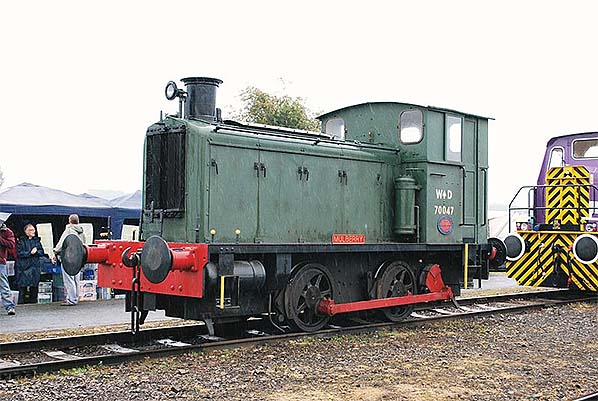
Barclay WD 70047 ‘MULBERRY’ on show at the Long Marston open day on 6 June 2009. One of Long Marston's Thomas Hill shunters, No.01512, nudges in behind. Although reasonably clean, her paintwork is scruffy and signs of corrosion are evident. This view gives an idea of the final drive arrangement; gearbox beneath cab driving transverse shaft with flycranks; jackshaft drive to leading axle; coupling rod to rear axle. This arrangement was once common but some manufacturers, notably Hudswell - Clarke, placed the gearbox at the front and this resulted in a most peculiar appearance. The steam-style chimney was also quite typical of early diesel shunters. The nameplates are probably not original. As will be realised whilst reading this article, the army tended to transfer names between locomotives, with the effect that names were allocated more to particular military railways than to particular locomotives. 'MULBERRY', for example, was applied to at least three locomotives at Marchwood. At Marchwood, at least, the army eventually abandoned the practice for the very reason of frequent locomotive changes, and nameplates were held in secure storage although they do still appear from time to time.
Photo by Hugh Llewelyn and reproduced from Wikimedia Commons under Creative Commons Licence
As far as is known WD 70047 was the only Barclay to work at Marchwood. The next to arrive were North British Locomotive Co. (NBL) 0-4-0DH (Diesel Hydraulic) types dating from around 1954/5 but it appears they did not arrive at Marchwood until sometime in the 1960s. There were six of them at Marchwood but not necessarily all at the same time. Among those known to have been used by the army at various locations bore the numbers Army 400-413 of which NBL works numbers were 27421-27429 (Army 400-408) and 27644-27648 (Army 409-413).
The army locomotives were a standard NBL product and similar to a batch supplied to British Railways, more-or-less at the same time, which became BR Nos. D2700-D2707 (originally 11700-9) and in particular to D2703-7, the first three being to an earlier and rather more antiquated design but employing the same equipment. The BR examples had a Paxman 6RPH engine set to give 200bhp at 1,000rpm and Voith L33YU torque converter built under licence by NBL. Drive was transmitted via NBL bevel gears, with a dog clutch reverser, and reduction gearing to jackshafts. The Army NBL locomotives have been seen quoted as being of 275bhp which would seem a little high for the type and although not impossible might be an error. The 200 - 225bhp range would be more likely. NBL later switched to using the built-under-licence German MAN (Maschinenfabrik Augsburg Nürnberg) W6V 17.5/22A engine, this practice resulting largely from the hope of winning large orders from BR during the second half of the 1950s. For reasons beyond the scope of this article, this 'built under licence' policy was one of the reasons for the ultimate demise of NBL
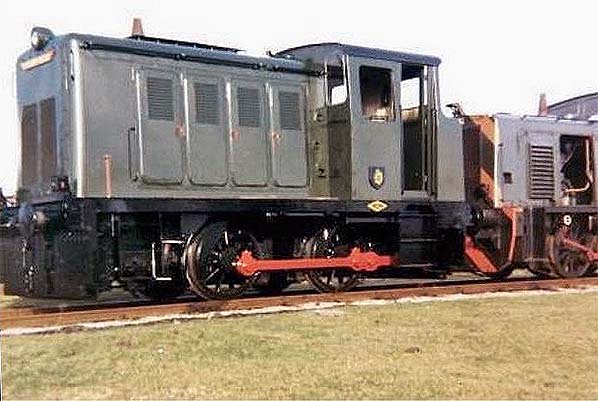
Army No.405 undergoing a repaint at Marchwood in November 1974 and in the company of one of the Ruston & Hornsby LSSH shunters. Army No.405 was w/n 27426/55 and displays the same style of radiator grille as applied to BR Nos.D2703 - 7 but has the rather odd looking 'piano back' rear to the driving cab as fitted to BR Nos.D2700 - 2. BR No.D2700 dated from 1953 and it is strange, although by no means unusual, to find a mix of older and newer features on later-built locomotives. The original radiator grille design applied to this type of shunter by NBL was a two-piece effort with pronounced curves at the top and although arguably stylish it harked back somewhat to the styles of the 1930s as indeed did the 'piano back' cab which was by no means unique to NBL as Barclay, to name one example, developed a penchant for it during the early 1950s. Of note in this view is the NBL worksplate, apparently well polished, fixed to the running plate instead of above the crest on the cabside.
Photo by Andy Crespin
The NBL works numbers for the army locomotives have already been given and they make an interesting (when there is nothing worth watching on television) comparison with those of the BR batch which were: D2700/1 - 27100/1/53; D2702 - 27102/54; D2703 to 6 - 27431 to 4/55; D2707 - 27435/56.
The final BR example, D2703, bowed out in February 1968 and D2700 had gone as early as November 1963 and the best service life any of them had with BR was just 12½ years. In contrast the military got at least twenty and in some cases almost thirty years out of them. A number of the type were also supplied to industrial users and many of these were equally long lived, often being taken out of service only because of the demise of the industries they served or curtailment of rail traffic. A number have survived into preservation, including at least one military example, as have two of the later and visually very different D2708 - D2780 BR batch.
Marchwood next saw the arrival of the Ruston & Hornsby 0-6-0DH LSSH type. Details of these in respect of Marchwood are a little patchy but it appears that at least four were operated, known examples being Army Nos.423/5/31/2, ex-works 1961/2*. It should be remembered that the army moves locomotives around frequently so Marchwood's allocation could have contained several others at various times and not just the four listed. [*Army 423/5 were ex-works June 1961 while conflicting works numbers for all four have been seen, hence they are not quoted here. Nos.431/2 are believed to have been new in 1962.]
A Ruston & Hornsby standard product, they came in LSSE form (diesel electric) and LSSH (diesel hydraulic) and the engine was the Paxman 6RPHL set to give 275bhp. The army versions were all LSSH and indeed all LSSH production went either to the military or to industrial users, in the case of the latter both at home and abroad. They were similar to the batch supplied to British Railways in 1962 to replace the USA tanks at Southampton docks. These were D2985 - D2998, later Class 07 but four were withdrawn without receiving TOPS numbers. Works numbers were 480686 - 480699. The main difference between the army and BR versions was the latter being the diesel-electric LSSE type. There were a number of other differences, mainly to comply with BR specification, but the most obvious visual difference, liveries aside, was the lower and less arched cab roof of the army version.
Reports suggest that the LSSH was the better of the two and was by far the easier to maintain. British Railways, incidentally, and with the Western Region excepted, had an aversion to hydraulic transmission despite purchasing several types of diesel multiple-unit and shunters so fitted. The reason that what became Class 07 was diesel-electric was, however, nothing to do with the aforementioned aversion but everything to do with the Southern Region being familiar with electrical traction equipment.
The Paxman 6RPHL engine was naturally aspirated and had above average reliability, being capable of continued operation with minimal maintenance and could tolerate long periods of idling - an inherent feature of shunting duties. Its one drawback, which was by no means unique, was difficulty starting from cold and especially after long periods out of use. The writer recalls watching the BR LSSEs working at Southampton docks during the 1970s and remembers them for being excessively noisy when accelerating owing, perhaps, to the original exhaust systems being inadequate. The transmission of the LSSH, which in tech-speak was hydro-mechanical, was simple and dependable. The army got over forty years service from their LSSHs which did not bow out until 2007. It is notable that Knights Rail Services, operators (as of 2016) of what was BR Eastleigh Works, have obtained four ex-army LSSHs (Army 422/5/8/33) for shunting duties alongside one ex-BR Class 07 (D2991/07007) which continues in service. Other Class 07 members have reached preservation, as have a few army LSSHs.
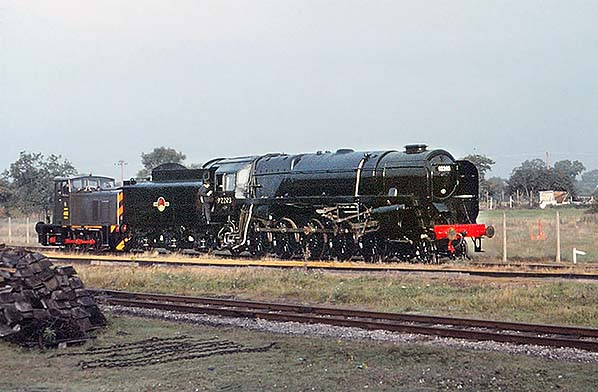
Ruston & Hornsby Army No.423 drags ex-BR Class 9F 2-10-0 No.92203 towards the exchange sidings in September 1979. The precise location is difficult to determine but the ensemble is probably about to come off the Cracknore Hard branch, the exchange sidings being out of view to the left. The 9F had been to Husband's Shipyard, located at Cracknore Hard, for boiler repairs. Husband's, apparently originally named Husband's Yacht Builders, were based on the Thames at Teddington and relocated to Marchwood in 1928. The company's current title is Husband's Shipyards Ltd. No.92203 was built and Swindon and ex-works on 6 April 1959. Withdrawn, after a pathetically short working life of just 8½ years, in November 1967 she was purchased straight out of BR service by the well known artist and conservationist David Shepherd, for the sum of £3,000. This figure, or thereabouts, was often quoted by BR for complete steam locomotives (Alan Pegler had purchased No.60103 ‘Flying Scotsman’ for the same price) and was based on scrap value. The 9F spent some time at the Longmoor Military Railway; at the time of her purchase, military and industrial systems were the few places were larger locomotives could be operated and properly maintained. She was named ‘Black Prince’ in preservation; only one of the 250-strong class had been named in BR days, this being No.92220 ‘Evening Star’ - the last steam locomotive built by British Railways. As of 2016 No.92203 is at, and owned by, the North Norfolk Railway, of all places. The BR Standard steam locomotives, of which the 9F was one, are often criticised as being a short-sighted waste of money. This is true in retrospect but after WWII Britain's railways emerged worn out but largely undamaged. Large scale electrification was desired but money was not forthcoming, being deemed, arguably rightly, better spent elsewhere at the time. The BR Standards were the result; far more were actually built than had been intended and were meant as a stopgap until money for electrification became available. The Standards had been envisaged as continuing in service until at least the 1980s but as we now know the 1955 Modernisation Plan, which in some ways was an expensive disaster, changed everything. The 9Fs were heavy freight locomotives and despite their relatively small driving wheels could - and did - also work passenger trains and were quite capable of reaching 90mph. No.92203 had, however, spent much of her short working life trundling between Bidston Dock and Shotton Steelworks - the exact type of work for which the
class had been designed.
Photo by Andy Crespin
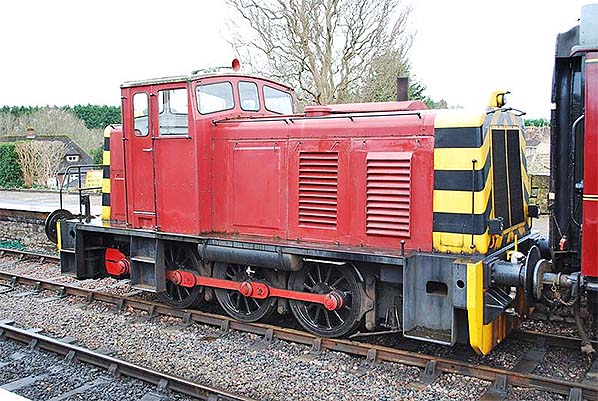
For a decent close-up view of an army Ruston LSSH it has been necessary to resort to a preservation-era photograph. This is ex Army No.429 at the Avon Valley Railway on 26 December 2012. She is given as Ruston & Hornsby w/n 466618/62.
Photo by Hugh Llewelyn and reproduced from Wikimedia Commons under Creative Commons Licence
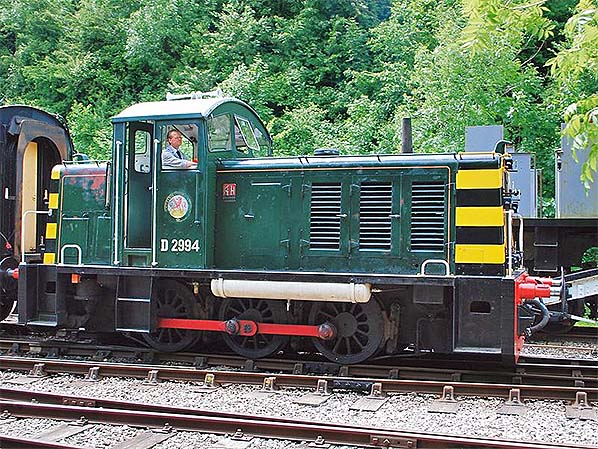
For comparison with the view of ex Army No.429 here is a preservation-era view of ex-BR No.D2994, also at the Avon Valley Railway, on 23 May 2009. This locomotive is w/n 480695/62 and ended up as BR No.07010, withdrawn in October 1976. A few of the class had been sold into industrial service but No.07010 was sold straight into preservation and was for a time at the West Somerset Railway. Features to note are the 'RH' maker's plate on the bonnet side ahead of the cab, the use of the BR coaching stock logo (this was a feature of their BR livery and not a preservation-era embellishment) and the short wheelbase. The latter feature is typical of shunters intended for the sharp curves found on industrial and dock railways. External differences between the Class 07 and the army version are readily apparent. The type was capable of 27mph, not bad for a shunter, and this makes them suitable for heritage railways which are legally restricted to a maximum speed of 25mph under normal circumstances. However, the type is prone to hotboxes (overheating axle bearings) during sustained running at maximum speed but in fairness to Ruston & Hornsby the type was never intended to do this. The 'problem' manifested itself when the first member of what became Class 07 was delivered from Ruston's works at Lincoln to the Southern Region under its own power. Subsequent deliveries were by means of road transport as delivery by rail on a well wagon or whatever would have caused gauging issues. Possibly, but unconfirmed, this was the reason for the army's LSSH's having cut-down cab roofs. Military locomotives were often moved from depot to depot via the main line under their own power, usually at night, but the hotbox problem with the Rustons may have necessitated movement on wagons and hence the cat-down roofs.
Photo by Hugh Llewelyn and reproduced from Wikimedia Commons under Creative Commons Licence
The next diesels to arrive at Marchwood were those current as this article was being prepared; the 4w Thomas Hill diesel-hydraulics. The designation '4w' means 4-wheel as opposed to 0-4-0 which has axles connected by coupling rods. Thomas Hill was a relatively little-known firm outside of industrial circles and only really came to the fore from the 1960s onwards. In view of this a condensed history is warranted.
Thomas Hill began in 1937 with small premises at Whiston, Rotherham, and was initially involved with repair and overhaul of Sentinel steam lorries, referred to by Sentinel as 'Steam Waggons' with the double 'g'. Thomas Hill later became involved with battery-electric vehicles in conjunction with Douglas (Kingswood) Ltd. This was the same Douglas (Kingswood is in Bristol) who produced motor cars (the 'Cyclecar') and motorcycles and is perhaps best known for the latter. Little is known of Douglas battery-electric vehicles other than that their main product appears to have been milk floats. Even less is known about the Thomas Hill involvement which in any event petered out when, or by the time, Douglas were taken over by Westinghouse Brake & Signal in 1957.
Sometime around the Second World War Sentinel developed a horizontal diesel engine intended for use in their own road vehicles and this appears to have materialised in the form of the Sentinel DV44 (and variants) lorry and then the STC4 single-deck bus. The original Sentinel diesel engine was a 4-cylinder horizontal unit of 6.08 litres, soon followed by a 6-cylinder unit of 9.12 litres - the 6SRH. In 1947 the existing sales and servicing agreement between Sentinel and Thomas Hill was extended to include Sentinel steam locomotives.
At some stage the company moved to 'new' premises at the closed Kilnhurst Central railway station. This station closed in 1968 and little trace remains today but the railway through it remains open. Thomas Hill occupied the former goods shed, hence 'new' in inverted commas, but in 1978 occupied new bespoke buildings on the same site. The works was rail connected and it was normal practice for locomotives to travel under their own power over the BR network if, in the case of ingoing, they were fit to do so.
In 1956 Thomas Hill obtained what appears to have been a rather casual agreement with F.C.Hibberd to act as agents for their Planet diesel shunting locomotives. Rather odd-looking machines with a small engine bonnet and large cab giving a 'shed on wheels' appearance, they sold reasonably well but were hardly prolific and a single example ended up in departmental service with British Railways. It became Departmental No.52 and was originally numbered 11104. It was for this reason that the Drewry shunters, later Class 04, which were originally numbered in the 111xx series lacked a 11104; what became D2203 was originally 11103 while D2204 was originally 11105. The discrepancy only disappeared when the steam-era numbering system for diesels was abandoned.
In the same year, 1956, came the takeover of Sentinel by Rolls-Royce but this process was by no means straightforward as Rolls-Royce had in mind only the building of their own diesel engines by Sentinel and thus leaving the production of Sentinel locomotives on the ‘cliff edge’. Thereafter came something of a quirk in railway history as Rolls-Royce agreed to the completion of Sentinel steam locomotive orders still outstanding, therefore it could be said that what emerged were, in a sense, the only steam locomotives to be built by Rolls-Royce. The following year Rolls-Royce decided to build complete diesel locomotives (all shunters, of course) and thus was born the once familiar 'Rolls Royce - Sentinel' brand name. As previously, new locomotives were demonstrated and tested on the old Shropshire & Montgomeryshire Railway.
At Kilnhurst Thomas Hill undertook a number of steam-to-diesel re-buildings but in 1960 began building their own locomotives. It was this which saw the end of the relationship with Hibberd who feared, perhaps rightly, that Thomas Hill would give priority to sales of its own products. The Thomas Hill diesel locomotives were based, perhaps unsurprisingly, on the underframes and running gear of Sentinel steam locomotives and it was for this reason many Thomas Hill diesels, including those at Marchwood, had the 4w chain drive layout. Both Rolls Royce - Sentinel and Thomas Hill also built locomotives with coupled wheels, 0-4-0 and 0-6-0, but it is the Sentinel steam locomotive derived 4w chain drive layout for which Thomas Hill became best known. The resulting locomotives, with or without coupling rods, were and still are known as 'Vanguards'.
Thomas Hill, by now officially Thomas Hill (Rotherham) Ltd, was to become a subsidiary of Rolls-Royce as opposed to a separate concern operating by agreement. Rolls-Royce also acquired the Yorkshire Engine Co (YEC) and Thomas Hill became involved with spares and repairs for YEC locomotives. Ultimately the small-scale production of the Sentinel works at Shrewsbury became something of a nuisance to Rolls-Royce who in 1971 were to be hit by a financial crisis. The result was Thomas Hill taking over the locomotive side completely but with Rolls Royce maintaining a stake in the company. The tables had, therefore, effectively turned.
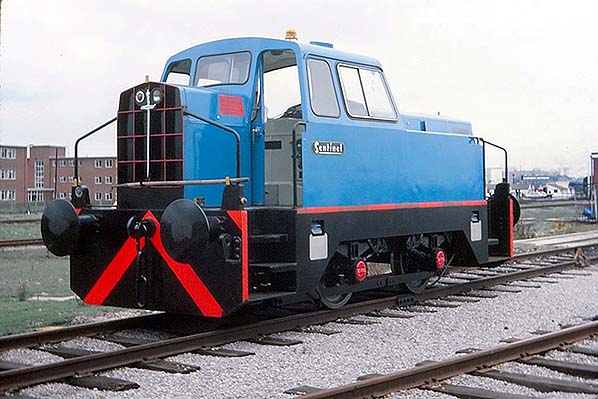
Rolls-Royce Sentinel Army No.244 at Marchwood in September 1976. The 255bhp diesel-hydraulic locomotive appears devoid of any form of Army identity. The red plate on the short bonnet warns that batteries must be disconnected if arc welding is to be undertaken on the locomotive. The Sentinel plate is prominent and near the top of the long bonnet towards the front is a plate which bore the words 'Powered by Rolls-Royce'. These locomotives are touched upon in the text concerning the Thomas Hill locomotives and were the result of the takeover of Sentinel by Rolls-Royce. In effect they were little more than a move by Rolls-Royce to keep the Sentinel works at Shrewsbury in operation albeit, as it turned out, temporarily. The design could be supplied in 4-wheel (as here), 0-4-0, 0-6-0 or 0-8-0 form. It was the 4-wheel form, with chain final drive to the axles, which was based upon Sentinel's steam locomotives and perpetuated by Thomas Hill. Army No.244 was apparently unpopular with Marchwood drivers and her history was quite typical of the type. Rolls-Royce w/n 10244 of 1966, she was new to Manchester Ship Canal as their DH30 and ended up with Thomas Hill, Kilnhurst, apparently for resale and not rebuilding, before going to RAF Quedgeley on 6 April 1972. She next moved to Marchwood on August 31 1976 and this will explain her non-Army livery as seen here. She was moved to RAF Chilmark on 12 March 1979 and then sent to Andrew Barclay, Kilmarnock, on 1 December 1986 for rebuilding. Given Barclay w/n 6528/87, she returned to Chilmark on 22 June 1987. Her subsequent fate is not known. Army No.244 was one of a pair obtained secondhand by the MoD, the other being No.245 and both had running numbers which matched the last three digits of their Rolls-Royce works numbers and this appears to have been deliberate. The type was known by the military as Class B8EQ. There were two further examples, Nos.242/3 of which numbers were duplicates of a pair of prewar Fowler 0-4-0 diesel-mechanical locomotives.
Photo by Andy Crespin
The demand for new shunting locomotives declined, not least because of the market being saturated by British Rail selling off large numbers of redundant diesel shunters, many of which were not even ten years old and had relatively low engine hours. The matter was compounded by Thomas Hill, being a small company producing small batches, never being competitive on price. Nevertheless Thomas Hill was to see saviour in sales to the military and the petroleum industry - at least temporarily. Through a hectic series of takeovers and mergers, at one point by Vickers as a result of that company's merger with Rolls-Royce, Thomas Hill was eventually swallowed up by Wabtec, Doncaster and the Kilnhurst works closed in 1993. Wabtec is an American company with interests and subsidiaries across the globe - quite an ending for the little company from Yorkshire.
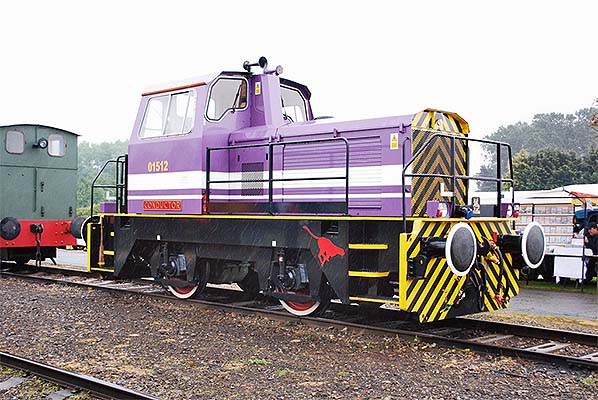
Unfortunately, to provide a good close-up view of one of the Thomas Hill Vanguard shunters it has been necessary to show a photograph taken at a location other than Marchwood. This is DLO class 01/5 No.01512 Conductor at Long Marston on 6 June 2009. The locomotive on the left is Barclay WD 70047. No.01512 is one of those with chain drive and no coupling rods; she is Thomas Hill w/n 319V of 1988 (the 'V' means 'Vanguard') and her Sentinel parentage is fairly obvious. The engine was originally the well-known Rolls-Royce C6SFL set to develop 255bhp but the examples at Marchwood, at least, now have Cummins engines set to develop 300bhp - a respectable power rating for a small 4w chain drive locomotive. Braking is air for both locomotive and train. Originally these locomotives wore the standard army green livery with MoD branding and numbers, No.01512 originally being Army No.301 and not among those known to have worked at Marchwood.
Photo by Hugh Llewelyn and reproduced from Flickr under Creative Commons Licence
Some explanation of DLO and Class 01/5 might be in order. DLO was Defence Logistics Organisation, a division of the Ministry of Defence created in 2000 to oversee support services for the armed forces and as such was of a semi military/semi civilian set-up. DLO was replaced in 2007 by a merger with the Defence Procurement Agency to form Defence Equipment and Support. DLO livery was purple and white as seen here and continues to be so, including at Marchwood, at the time of writing.
Class 01/5 is a TOPS designation. TOPS, Total Operations Processing System, originated with the Southern Pacific Railroad (now Southern Pacific Transportation Company) in the USA. It is a computerised system designed to simplify the identification of locomotives and rolling stock. TOPS is based upon an IBM system which British Rail decided to adopt in 1968 but which did not appear on locomotives until 1973. British Rail, however, had been looking for a means by which to simplify their numbering system from sometime around 1965/6 and the result was the class numbers we know today, their application in the TOPS system coming later, as we have seen. It was for this reason that many locomotives which were withdrawn during the 1960s and early 1970s received class code numbers but continued to carry their original numbers. A few examples were the Metro-Vick Co-Bo (Class 28); North British Type 2 (Classes 21/2/9); BTH and NBL Type 1 (Classes 15 and 16). There were also some curiosities, for example the Barclay 0-6-0 shunters D2400 - 9 and the Hudswell - Clarke D2500 series, all of which were withdrawn by 1968, were lumped-in with Class 05 of which only one example, Hunslet D2554, survived long enough to receive a TOPS number (05001).
Class 01 had its origins with the two Barclay shunters (D2954/5) which survived at Holyhead Breakwater to become 01001/2 but otherwise has no connection with the present Class 01/5 which is for privately-owned (the term is itself somewhat academic given Britain's railways are now supposedly 'privatised') locomotives permitted to run on the national network. This does not mean that 01512 or others like her could one day turn up at the head of the 07:28 to Paddington but that they can operate over Network Rail tracks within exchange sidings and when travelling to and from works or when being transferred from one location to another. This is nothing new irrespective of rail 'privatisation' as military and, especially, National Coal Board locomotives always have travelled on the national network when necessary and the TOPS coding simply identifies these permissions. It does not necessarily, however, apply to Class 01/5 locomotives which have entered preservation unless their 'main line registration' has been maintained.
A number of Thomas Hill Vanguards have worked - and still do - at Marchwood and known examples from various times are:
Army 252 TOPS 01544 ‘MULBERRY’ TH270V/77
Army 254 TOPS 01522 TH272V/77
Army 256 TOPS 01527 ‘MARLBOROUGH’ TH274V/77
Army 258 TOPS 01549 TH298V/81
Army 259 TOPS 01523 TH299V/81
Army 260 TOPS 01541 TH300V/82
Army 262 TOPS 01542 TH302V/82
Army 263 TOPS 01543 ‘McMULLEN’ TH303V/82
Army 266 TOPS 01547 ‘MULBERRY’ TH308V/83
The list is examples known to have worked at Marchwood up to 2015. There may or may not have been others and there will certainly be others in the future. There are normally five or six at Marchwood at any one time and two locomotives bearing the name ‘MULBERRY’ can be explained by nameplates being retained at Marchwood and removed/replaced as locomotives are moved from depot to depot. Some on the above list have been disposed of (as of 2016) to, for example, heritage railways and Harry Needle Railroad Co, a locomotive spot hire company based at Barrow Hill and usually abbreviated to HNRC. Just to make things a little confusing, some members of Class 01/5 on heritage railways are owned by HNRC. Providing Marchwood Military Railway remains in operation - and as of 2016 it is looking very much as if it will - the Thomas Hill locos will eventually be phased out and replaced by somebody else's offerings but what they may be remains to be seen. It will be noticed that the above list is given in Army number order which does not concur with TOPS number order but the reason for this is unclear. There are also blocks of 01/5 numbers which have never been issued and again the reason is unclear.
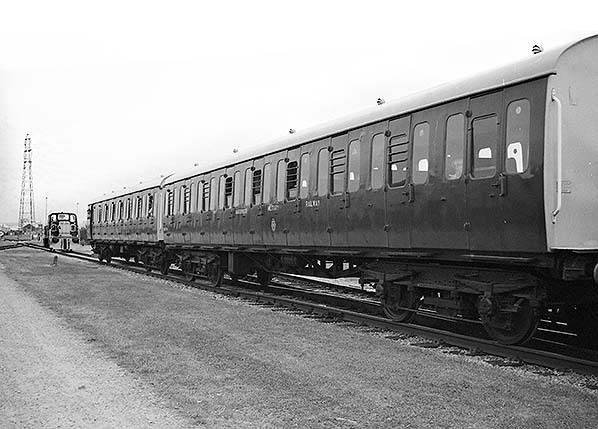
One of Marchwood's Thomas Hill diesel-hydraulic shunters in army green livery is seen here in June 1995 fussing around the pair of ex BR Class 501 EMU vehicles which replaced the two ex-BR Mk1 corridor coaches. Unlike earlier passenger stock, fuller details of the two Class 501 vehicles and the ex-Gatwick Express set which replaced them are known and will be described in the text
To conclude Marchwood's diesel locomotives there was one other locomotive to complete the picture. This was an ancient John Fowler 0-4-0 diesel - mechanical w/n 22503 of 1938. Of just 60bhp it was delivered to the Ministry of Supply on 24 October 1938 at their Chilwell (Notts) depot. It is recorded as being fitted when new with engine no.6B/M1148. Chilwell depot, incidentally, is now known as Chetwynd Barracks and was built on the site of one-time National Shell Filling Factory which was wrecked in an explosion in July 1918. The Chetwynd name came from Godfrey Chetwynd, 8th Viscount Chetwynd who had been manager of the National Shell Filling Factory. Chilwell was at one time a Central Ordnance Depot and non-steam locomotives were desirable at such places for obvious reasons. Marchwood, it should be remembered, is not an ordnance depot so there was no urgency to eliminate steam traction, which continued until 1979.
Not a great deal is known about Fowler 22503 other than that it had been at Bicester, apparently stored out of use after 1969, until shipped to Germany on 15 October 1973 and ended up plinthed as, apparently, a mascot for 79 Railway Squadron and named 'Percy'. It returned to the UK at Marchwood and as a non-runner stood on the tracks at Marchwood in very scruffy condition and its present whereabouts is not known. As a point of interest, 79 Railway Squadron was part of 17 Port and Maritime Regiment, Royal Logistic Corps and was relocated to Marchwood from Mönchengladbach, Nordrhein-Westfalen (North Rhine - Westphalia) in 1999 when it was renamed 79 Port Enabling Squadron RLC, still under the command of 17 Port and Maritime Regiment but was disbanded, at Marchwood, on 13 May 2012. The little Fowler would likely have returned to the UK via Marchwood anyway but the relocation of 79 Railway Squadron would explain its presence above all else. In Germany it was seen in 1993 in a smart livery of either dark green and red or black and red (this is not entirely clear from photographs of it in Germany) with 'No.' behind its cab entrances but with no actual number and 'WD' in very large letters ahead of the cab entrances and which rather untidily extended over the heavy red lining around the cabside panels. Back at Marchwood it stood in a rather unpleasant and badly faded blue lined white livery which, allowing for fading, may have began life as something else, but still with the cabside inscriptions. Subsequently it was repainted in a lined green livery, rather more neatly applied than the livery it had worn in Germany.
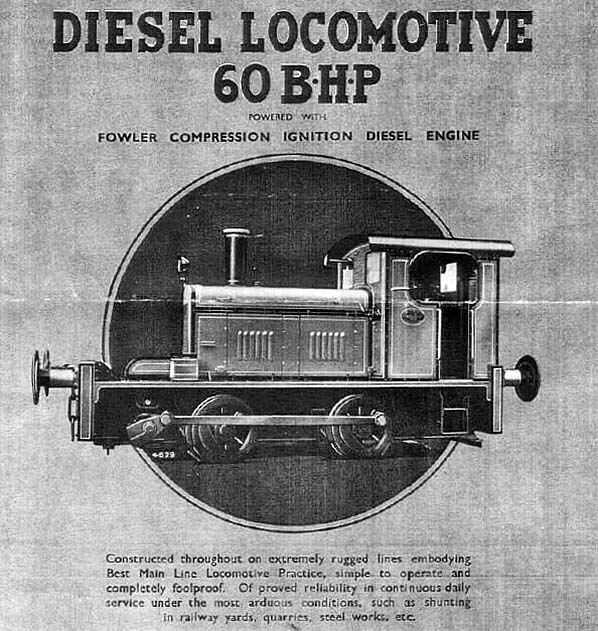
John Fowler & Co., Leeds, publicity document from the 1930s showing the same type of locomotive as described in the text. The document is in some ways quite amusing in a manner not untypical of the time. 'Compression Ignition Diesel Engine', for example, is a somewhat pointless statement as with the exception of a few early experiments all diesel engines are compression ignition. 'Arduous conditions, such as shunting in railway yards, quarries, steel works, etc.' is another rather pointless statement as where else would one find a diesel shunter working? Of note regarding these early Fowlers is the bufferbeams projecting up above the running plate. This was necessary to allow these diminutive locomotives, which stood no taller than a standard gauge open wagon, to shunt standard wagons. Later Fowlers, albeit to the same general appearance, had higher running plates (and more powerful engines) and thus were rather better proportioned. The gearbox was at the front, hence the overhang - a feature of many early diesel shunters.
Scan from leedsengine.info and reproduced under their terms of reuse
As far as is known, no Fowler diesel shunters ever worked at Marchwood with the only appearance being that of No.22503. The type did, however, work at the nearby Fawley Refinery at one time. Larger and more powerful versions of the same type seen above were also used by the main line railways, with the GWR and LMS both having an example. LMS No.2 went on to become British Railways No.ED1 and it was unpopular with drivers due to the semi-open and unheated cab. British Railways also purchased later models from Fowler but these were far more powerful machines with an offset centre cab. These became ED2 - 6 plus a couple of others on the Southern, Nos.400S and 600S. There was also the relatively little known ED7, an older machine, w/n 22891 of 1940, purchased second hand from the Ministry of Supply in 1955. It was acquired in 1955 and seems to have worked at Fazakerley, Liverpool, until 1962 when it suffered some sort of failure. Thereafter it languished at Derby works until scrapped in 1964 having never been repaired. All the BR Fowler shunters disappeared during the 1960s, the final two going in 1968. The real antique, No.ED1, w/n21048 of 1935 had gone in June 1962 having seemingly spent much of its time out of use awaiting repairs.
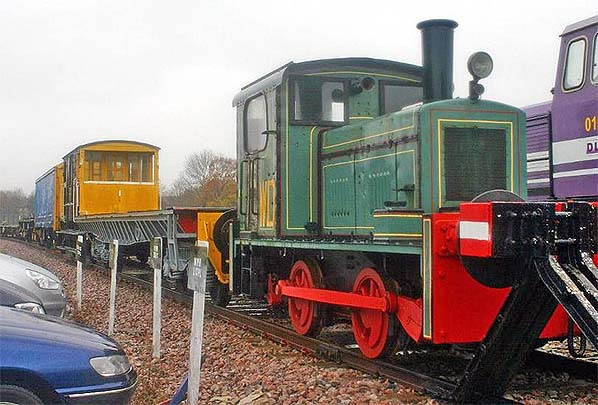
A recent photograph of Fowler 22503/38 at Marchwood following a re-paint. It is in the company of a Thomas Hill shunter and various Internal User wagons including an ex-BR brakevan and a PVA curtain-sided van. This photograph was saved from the internet but the source has not been retraced. If you can claim copyright please get in contact.
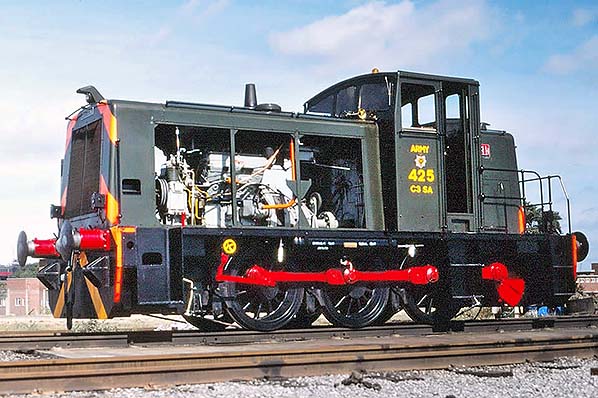
Indecent Exposure courtesy of Ruston Class C3 SA Army No. 425 at Marchwood in October 1978. On view is the Paxman 6RPHL engine and, between it and the radiator, the air compressor. The code 6RPHL means 6 cylinders, RP Ricado Paxman (relates to the fuel injection system), H 7½in diameter cylinders, L Locomotive application. Data issued by Ruston & Hornsby in 1960 for the LSSH states the engine is set to deliver 275bhp at 1,360rpm, giving a maximum road speed of 18mph. The LSSE as delivered to BR Southern Region had a maximum road speed of 27mph; this was a Southern Region fad intended to make their diesel shunters suitable for trip working and therein probably lies the reason for what became Class 07 being prone to overheating bearings. The Ruston LSSH/E was a neat and, for its time, a modern looking design. The offset centre cab allowed wider distribution of equipment and, in turn, better visibility for the driver. Ruston was, however, by no means the first or the only manufacturer to adopt this layout. The shorter, stubby bonnet housed, among other items of equipment, the reversing gearbox and final drive unit. Other features to note are the railings around the rear of the running plate, cab roof warning beacon, sideways facing warning horn and the shielded headlamp. On top of the long bonnet, the conical device is the exhaust stack and, next to it, the engine air intake. The triangular devices on the bufferbeam are jacking points
Photo by Andy Crespin
Summary List of known Marchwood Locomotives
Locomotives on the Marchwood Military Railway (MMR) have been described essentially where photographs of the various types appear. However, for the benefit of modellers, enthusiasts and historians a list is presented below and not all locomotives on it have been mentioned in the text. The original list was compiled by hand by a former member of MMR staff and kindly scanned for inclusion in this feature. The list as supplied covered the period 1952 to circa 1990 but has been expanded, with greater details and comments added, by the author of this feature. Readers are reminded that the transient nature of military locomotives means the list below is not guaranteed to be complete and especially where the earlier years are concerned.
Steam Locomotives
As far as is known, all steam locomotives at Marchwood have been of the Austerity 0-6-0 Saddle Tank type but the one grey area concerns the period between when construction of Marchwood Military Port began and when it opened in November 1943. Records of the Industrial Railway Society state the Ministry of Supply did not place its first orders for the Austerity until September 1943, by which time construction of the port was well underway so precisely what motive power was present during the construction phase prior to September 1943 must for now remain a mystery. Similarly it is not known what motive power could be found on the Cracknore Hard branch which, of course, dated from 1939 and thus predated the port but is assumed to have been worked by Southern Railway locomotives, perhaps with a diesel shunter used in the vicinity of the Magazines.
A further mystery concerns which locomotives worked at Marchwood between the end of 1945 and circa 1950, if any. It should be remembered that Marchwood Military Port was built primarily for the purpose of constructing Mulberry components. Following the end of hostilities in Europe and despite troops and equipment probably being brought home via Marchwood, there would have been a lull in operations while the future of the port in a peacetime role was considered and alterations made accordingly. It is therefore not unreasonable to suggest no locomotives were at Marchwood during the period in question, although realistically this is unlikely. Any rail traffic would have been intermittent while the immediate postwar future of the port was under consideration and such intermittency may have been covered by the presence of a couple of diesel shunters, either owned by or loaned to the WD, although it must be stressed that no evidence of such has been found.
Steam locomotives are listed, as far as has been possible, in the order they appeared at Marchwood. In some cases a little history of individual locomotives is known and where applicable this has been given on the first page of this Feature and in certain image captions. A list of relevant manufacturers also appears on the first page.
- 5091/75091 HC1752/43. (November 1943 - 15 August 1945). Believed new to Marchwood.
- 5074/75074 RSH7110/43 (February 1944 - May 1944)
- 5054/75054 RSH7090/43 (19 April 1944 - 1 May 1944)
- 5181/75181 RSH7131/44 (May 1944 - July 1945)
- 5114/75114 HE3164/44 (May 1944- July 1945)
- 5072/75072 RSH7108/43 (May 1944 - July 1945)
- 5184/75184 RSH7134/44 (1944 - ?) This locomotive went on to become LNER/British Railways Class J94 No.68022 and survived until 1960. Believed new to Marchwood.
- 75290/186 MANIPUR ROAD VF5280/45 (October 1950 - June 1953)
- 75291/187 VF5282/45 (December 1953 - June 1954)
- 75189/152 RENNES RSH7139/44 (June 1953 - May 1956)
- 75277/178 FOLINGO RSH7207/45 (October 1954 - May 1955)
- 75040/106 SPYCK HE2889/43 (? 1944 - ? 1949 and May 1955 - May 1960)
- 71443/157 CONSTANTINE HE3207/45 (November 1955 - November 1958)
- 192/92 WAGGONER HE3792/53 (June 1973 - November 1979*) *No.92 is believed to have last operated at Marchwood in October 1979 and transferred away the following month. She was the last Army steam locomotive at Marchwood.
These are listed first according to manufacturer and then by dates at Marchwood.
Andrew Barclay:
- 827 MULBERRY 0-4-0 diesel-mechanical (February 1960 - June 1965)
- 844 0-4-0 diesel-mechanical (June 1965 - July 1969)
Hunslet:
- 855 0-6-0 diesel-mechanical (April 1965 - July 1966). This interesting machine was Hunslet w/n 1846 of 1937 and as WD No.1 was supplied new to Corsham Ammunition Depot and had a cut-down cab and exhaust conditioner for working in the tunnels at Corsham. Rated at 155/170bhp, Corsham specification aside it was similar to LMS No.7051. Two further Hunslets were supplied to Corsham, these being based upon LMS No.7054 and were the first application of the Gardner 8L3 204bhp engine to rail traction; this engine going on to be installed in hundreds of British Railways diesel-mechanical shunters of various types. For further information on WD No.1 see photograph and caption below.
North British (all 0-4-0 diesel-hydraulic):
- 8205 MATRUH (June 1962 - May 1965, then June 1966 - November 1968). As Army No.405 (June 1969 - November 1974)
- 407 (June 1968 - June 1975)
- 413 (July 1974 - June 1976)
- 401 (October 1971 - August 1973)
- 409 (Believed November 1977 - August 1979).
Rolls-Royce Sentinel (4w diesel-hydraulic):
- 244 (August 1976 - March 1979).
Ruston & Hornsby:
- 809 PLUTO (June 1962 - April 1963). Recorded as being a 4wDM (4-wheel diesel-mechanical), like the Hunslet this locomotive is also rather mysterious. The designation '4wDM' suggests it was either of Ruston's rather puny 48DS type or of the slightly less puny 88DS type. The name PLUTO suggests the locomotive came to Marchwood from one of the PLUTO pumping stations.
Note: PLUTO (Pipe Line Under The Ocean) was a system of undersea pipelines supplying fuel to Allied forces following D-Day. There were two undersea pipelines; Shanklin to Cherbourg and Dungeness to Boulogne plus a third between Fawley and Shanklin. Fuel was supplied from a number of refineries via pumping stations, some of which were well inland. Today, some surface sections of the PLUTO pipeline can still be seen, such as at Shanklin. For more information see here.
The following Marchwood Ruston's were all of the 0-6-0 LSSH diesel-hydraulic type.
- 425 (February 1973 - March 1986) Later named VENOM. Now TOPS 01507.
- 432 (October 1974 - June 1986)
- 423 (June 1980 - March 1985)
Also No.431, new to MoD Donnington along with No.432, which appeared briefly at Marchwood..
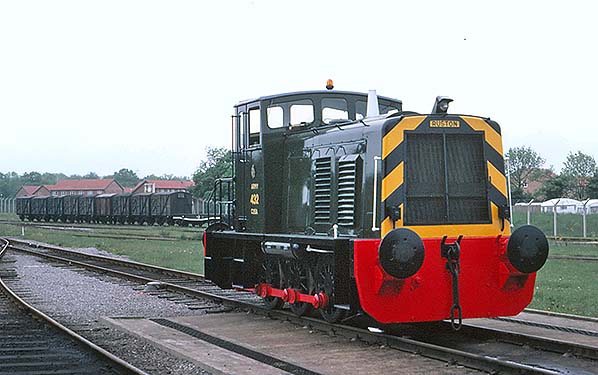
Ruston & Hornsby Army No.432 poses proudly for the camera following an overhaul and repaint, with which project the photographer was involved. This was the final Ruston LSSH at Marchwood and she was transferred by road to Donnington in June 1986 shortly after this photograph was taken. Note the vans, left background, most of which appear to be Palvans (Pallet Vans). Much of the housing in the background had sprung up in the six or so years prior to this photograph being taken.
Photo by Andy Crespin
Thomas Hill (All of the Vanguard 4w diesel-hydraulic type)
- 268 MARCHWOOD (March 1984 - ?) Now TOPS 01529
- 269 McMULLEN (April 1984 - October 1991) Now TOPS 01530
- 266 MULBERRY (March 1985 - ?) Now TOPS 01547
- 258 (April 1988 - September 1989, January 2015 - Current 2016) Now TOPS 01549
- 263 MULBERRY (November 1990 - ?) Now TOPS 01543. Also carried the name McMULLEN
- 255 (October 1991 - ?) Now TOPS 01546
- 256 MARLBOROUGH (October 1991 - Current 2016) Now TOPS 01527
- 262 Now TOPS 01542 (January 2015 - Current 2016)
- 252 MULBERRY. Now TOPS 01544 (?)
- 254 Now TOPS 01542 (? - Current 2016)
- 259 Now TOPS 01523 (? - Current 2016)
- 260 Now TOPS 01541 (? - Current 2016
The duplication of names is explained by the army policy in recent times of retaining nameplates at Marchwood and removing / refitting them as locomotives are transferred to and from other depots. Readers are again reminded that military locomotives are moved around frequently and those tagged 'Current 2016' may not remain so for very long.
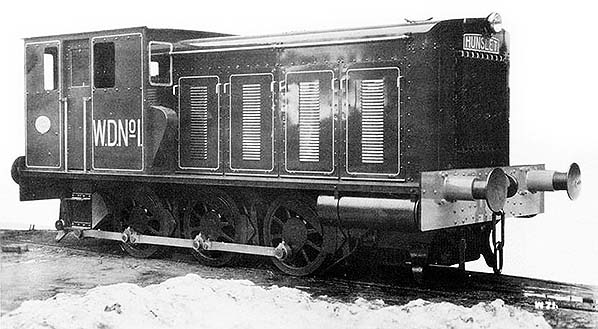
Hunslet WD No.1, HE 1846/36 (sources vary between 1936 and 1937 so the photo of the worksplate should clear up any confusion), later Army No.855. This locomotive was at Marchwood between April 1965 and July 1966. She was supplied new to Corsham Ammunition Depot and for working in the tunnels there she had a cut-down cab and exhaust conditioner and, these differences aside, was similar to LMS No.7051. Rated when new at 156/170bhp, the original engine make and model is not known and, prewar, Hunslet dabbled with a number of engines from various manufacturers. Transmission would have been Hunslet's patent friction clutch with 4-speed epicyclic gearbox and final drive incorporating a reversing geabox (necessary to allow equal speeds in either direction), then via jackshafts to the rear axle with coupling rods linking all three axles. The locomotive would have been air braked but no train brakes were fitted. Two further Hunslets joined No.1 at Corsham; known to have become No.856/7 and presumably originally WD Nos.2 and 3. The latter pair, and presumably also No.1, were eventually rebuilt with more conventional cabs and given Gardner 8L3 engines of 204bhp. In this form they resembled externally LMS No.7054 and sowed the seeds for 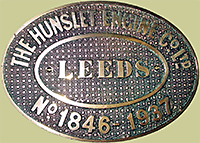 what became, with further alterations and especially to outward appearance, Hunslet's standard diesel shunter which was perhaps best known as British Railways 204bhp D2550 series (Class 05). Not to be confused with a narrow gauge WD No.1 at Corsham, Hunslet No.1 was rebuilt to standard loading gauge at Bicester in 1962/3. Following removal from Marchwood she returned to Bicester and on 30 April 1968 was sold to Tunnel Portland Cement of Gartsherrie, Lanarkshire. Believed out of use by or during December 1969, she had been scrapped by June 1971. MoD Corsham is itself interesting and HM Government has produced a Brief History which includes, among others, a photograph of the tunnel leading from the main line. During the Cold War Corsham would have been the underground base for the government in the event of nuclear attack. The tunnels may well have been the source of the myth, which lingers to this day, concerning a 'strategic reserve' of steam locomotives hidden away from public view
what became, with further alterations and especially to outward appearance, Hunslet's standard diesel shunter which was perhaps best known as British Railways 204bhp D2550 series (Class 05). Not to be confused with a narrow gauge WD No.1 at Corsham, Hunslet No.1 was rebuilt to standard loading gauge at Bicester in 1962/3. Following removal from Marchwood she returned to Bicester and on 30 April 1968 was sold to Tunnel Portland Cement of Gartsherrie, Lanarkshire. Believed out of use by or during December 1969, she had been scrapped by June 1971. MoD Corsham is itself interesting and HM Government has produced a Brief History which includes, among others, a photograph of the tunnel leading from the main line. During the Cold War Corsham would have been the underground base for the government in the event of nuclear attack. The tunnels may well have been the source of the myth, which lingers to this day, concerning a 'strategic reserve' of steam locomotives hidden away from public view
Photo from Andy Crespin collection
Click here to continue Marchwood Military Railway

















 what became, with further alterations and especially to outward appearance, Hunslet's standard diesel shunter which was perhaps best known as British Railways 204bhp D2550 series (Class 05). Not to be confused with a narrow gauge WD No.1 at Corsham, Hunslet No.1 was rebuilt to standard loading gauge at Bicester in 1962/3. Following removal from Marchwood she returned to Bicester and on 30 April 1968 was sold to Tunnel Portland Cement of Gartsherrie, Lanarkshire. Believed out of use by or during December 1969, she had been scrapped by June 1971. MoD Corsham is itself interesting and HM Government has produced a
what became, with further alterations and especially to outward appearance, Hunslet's standard diesel shunter which was perhaps best known as British Railways 204bhp D2550 series (Class 05). Not to be confused with a narrow gauge WD No.1 at Corsham, Hunslet No.1 was rebuilt to standard loading gauge at Bicester in 1962/3. Following removal from Marchwood she returned to Bicester and on 30 April 1968 was sold to Tunnel Portland Cement of Gartsherrie, Lanarkshire. Believed out of use by or during December 1969, she had been scrapped by June 1971. MoD Corsham is itself interesting and HM Government has produced a 
 Home Page
Home Page